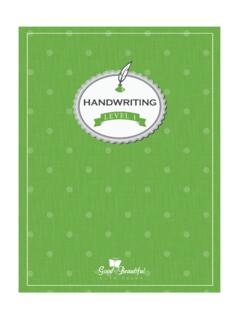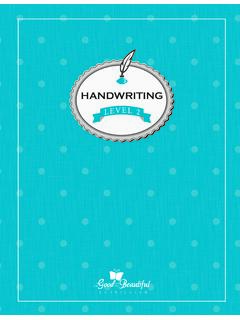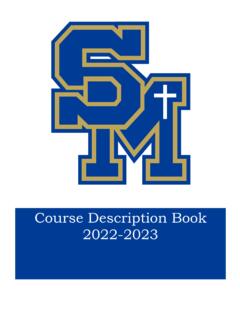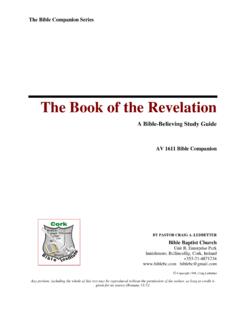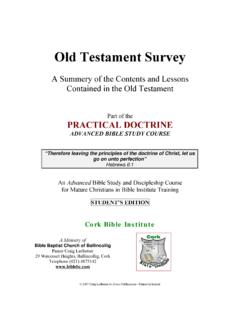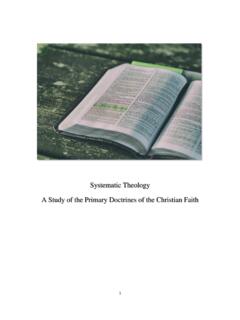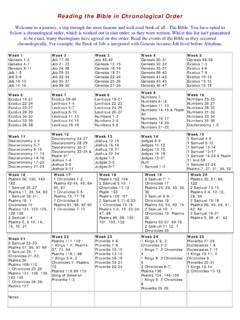Transcription of Student Explorer 4-6
1 Year 1 - Student Explorerhistory 2016 Jenny Phillips | rights reserved. No part of this book may be copied or reproduced in any way without wri en permission from the 4-6 Jenny Phillips1 History - Year 1 - Grades 4-6 Lesson 1 Day 1 Day 2 Day 3 Day 4 Day 5 Day 6 Day 7"In/the beginning God created/the heavens and/the earth." genesis /1:1"He/rested/from/all/Hi s/work/which he created" genesis /2:3 Day NightSky (no sun, moon, or stars yet)Sun, Moon, StarsLand and PlantsBirds and FishAnimals and Manthe creationTrace the scriptures. Illustrate each day of crea on. Jenny Phillips2 History - Year 1 - Grades 4-6 Lesson 3 Noah displayed the following noble traits; Circle the two with which you were most impressed: obedience, faith, gra tude, courage, willingness to follow God when others would a picture of Noah's Ark.
2 Write genesis 6:22 in cursive. All that God commanded him, so did he. //////////////////////////////// ////////////////////////////////History HeroNoahAn Obedient Old Testament Prophet Jenny Phillips3 History - Year 1 - Grades 4-6 Lesson 4 Using the map on page 193 of the Th e Big Book of History Stories as a reference, draw a map of ancient Egypt. Include all the labels on the map. Jenny Phillips4 History - Year 1 - Grades 4-6 Lesson 4 Color the picture of ancient Egyp an culture. Jenny Phillips5 History - Year 1 - Grades 4-6 Lesson 5 Egyptian HieroglyphicsUsing the chart above, write your fi rst and last name in hieroglyphics.
3 Which is faster wri ng your name with hieroglyphics or the English alphabet?abcdefg h iabcde f gh ijklmno p q rjk Same as Clmnopq rstuvwxyzstuV Same as Uwx y zUse the chart above to decode the sentence, and write it on the blank is the gift of the nile//////////// //// /////// ////////// ///////////// ////////////. Jenny Phillips6 History - Year 1 - Grades 4-6 Lesson 5 Egyptian Books Read the following by James Baikie (from his book Peeps at Ancient Egypt).The Egyp ans were among the earliest of all the peoples of the world to fi nd out how to make a book; and one of their old books, full of wise advice from a father to his son, is one of the oldest surviving books in the world.
4 The Egyp ans were the fi rst people to make paper, and they used it for many centuries before other people had learned how much handier it was than the other things which they , if you saw an Egyp an book, you would think it was a very curious and clumsy thing indeed and very diff erent from the handy volumes which we use nowadays. When an Egyp an wanted to make a book, he gathered the stems of a kind of reed called the papyrus, which grew in some parts of Egypt in marshy ground. This plant grew to a height of from 12 to 15 feet, and had a stalk about 6 inches thick. The outer rind was peeled off this stalk, and then the inner part of it was separated by means of a fl at needle, into thin layers.
5 These layers were joined to one another on a table, and a thin gum was spread over them, and then another layer was laid crosswise on the top of the fi rst. The double sheet thus made was then put into a press, squeezed together, and dried. When the Egyp an had got his paper, he did not make it up into a volume with the sheets bound together at the back, as we do. He joined them end to end, adding on sheet a er sheet as he wrote, and rolling up his book as he went along, so, when the book was done, it formed a big roll, some mes many feet long. There is one great book in the Bri sh Museum which measures 135 feet in length.
6 You would think it very strange and awkward to have to handle a book like if the book seemed curious to you, the wri ng in it would seem s ll more curious, for the Egyp an wri ng was certainly the quaintest, and perhaps the pre est, that has ever been known. It is called "hieroglyphic," which means "sacred carving," and it is nothing but li le pictures from beginning to end. The Egyp ans began by pu ng down a picture of the thing which was represented by the word they wanted to use, and, though by-and-by they formed a sort of alphabet to spell words with, and had, besides, signs that represented the diff erent syllables of a word, s ll, these signs were all li le pictures.
7 When the Egyp ans wanted any of their wri ngs to last for a very long me, they did not trust them to the frail papyrus rolls, but used another kind of book altogether. You have heard of "sermons in stones"? Well, a great many of the Egyp an books that tell us of the great deeds of the Pharaohs were wri en on stone, carved deeply and clearly in the hard granite of a great obelisk, or in the limestone of a temple wall. When one of the Kings came back from the wars, he generally published the accounts of his ba les and victories by carving them on the walls of one of the great temples, or on a pillar set up in the court of a temple, and there they remain to this day for scholars to the hieroglyphics were cut in stone, the lines were o en fi lled in with pastes of diff erent colors, so that the whole wri ng was a blaze of beau ful nts, and the walls looked as if they were covered with fi nely-colored hangings.
8 Of course, the colors have A portion of the Book of the Dead Jenny Phillips7 History - Year 1 - Grades 4-6 Lesson 5mostly faded now, but there are s ll some temples and tombs where they can be seen, almost as fresh as when they were fi rst laid on, and from these we can gather some idea of how wonderfully beau ful were these stone books of ancient Egypt. The scribes and carvers knew very well how beau ful their work was, and were careful to make it look as beau ful as possible. So much so, that if they found that the grouping of fi gures to make up a par cular word or sentence was going to be ugly or clumsy, they would even prefer to spell the word wrong, rather than spoil the appearance of their picture wri ng.
9 But now, let us turn back again to our papyrus roll. Suppose that we have got it, clean and fresh, and that our friend the scribe is going to write upon it. How does he go about it? To begin with, he draws from his belt a long, narrow wooden case, and lays it down beside him. This is his pale e; rather a diff erent kind of pale e from the one which ar sts use. It is a piece of wood, with one long hollow in it, and two or three shallow round ones. The long hollow holds a few pens, which are made out of thin reeds, bruised at the ends, so that their points are almost like li le brushes. The shallow round hollows are for holding ink black for most of the wri ng, red for special words, and perhaps one or two other colors if the scribe is going to do a very fi ne piece of work.
10 So he squats down, cross-legged, dips a reed-pen in the ink, and begins. As he writes he makes his li le fi gures of men and beasts and birds face all in the one direc on, and his readers will know that they must always read from the point towards which the characters face. Now and then, when he comes to some specially important part, he draws, in gay colors, a li le picture of the scene which the words , you can understand that this picture wri ng was not very easy work to do when you had nothing but a bruised reed to draw all sorts of animals with. Gradually the pictures grew less and less like the creatures they stood for to begin with, and at last the old hieroglyphic broke down into a kind of running hand, where a stroke or two might stand for an eagle, a lion, or a man.





